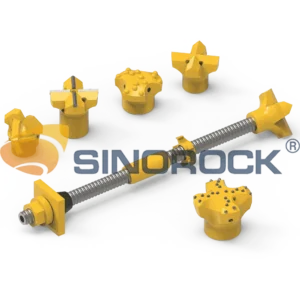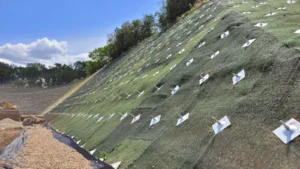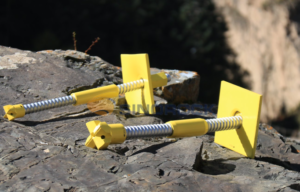The rapid growth of urban populations and the increasing demand for urban functionality have made land in cities increasingly scarce. In response, urban development has increasingly turned to underground spaces, which are now seen as essential to the sustainable expansion of cities. The twenty-first century is poised to be the “century of underground space,” and the development of underground space is highly dependent on efficient underground support technology.
Among the various technologies available for underground support, anchor systems—such as anchor rods and anchor cables—are crucial. These technologies are cost-effective, applicable in a wide range of scenarios, and easy to construct. Their versatility and efficiency have made them widely used in various fields, from mining projects to tunneling, slope stabilization, and even in the construction of dams. In this article, we explore the evolution of anchor technology, its applications, and how modern innovations like the split set rock bolt-anchor cable combination support structure are changing the landscape of underground construction.
Evolution and Importance of Anchor Support Technology
The Emergence of Anchor Technology
Anchor technology has a long and storied history, dating back to the late 19th century. The first use of steel reinforcements in slope rock was recorded in 1890 at an opencast coal mine in North Wales. This early use of anchor systems marked the beginning of a new era in geotechnical engineering. Between 1890 and 1918, countries like the United States and Poland followed suit, applying similar techniques to reinforce mine roadways.
By the 1930s, the application of prestressed anchor cables for large-scale infrastructure projects became more widespread. For example, in Algeria, a prestressed anchor system was used in the Chel Paddles Dam to provide stability. By the 1950s and 60s, prestressed anchor cables were commonly used in a variety of civil engineering projects, including dams, tunnels, and roadways.
The technology continued to evolve throughout the 20th century, with advancements in materials and techniques. By the 1970s, prestressed anchor cables had gained significant traction in countries like the United Kingdom, where they were applied in the construction of dry docks for nuclear submarines. In the 1990s, research into the theoretical aspects of soil anchoring and technological innovations began to accelerate, particularly in Europe and Japan, further enhancing the capabilities of anchor systems.
China’s Adoption of Anchor Technology
China began to explore anchoring technology in the late 1950s. Initial applications were found in the mining sector, particularly in projects like the Beijing West Mining Bureau and the Hebei Longyan Iron Ore Mine. By the 1980s, China had made significant strides in developing tensioning equipment and prestressing rods, marking the beginning of large-scale applications of anchor systems in the country.
The 1990s saw China applying advanced anchoring techniques in dam reinforcement projects such as the Fengmeng Hydropower Station and the Longyangxia Hydropower Project. The successful testing of 10,000kN-level prestressing anchor rods demonstrated China’s growing capabilities in anchor technology. However, while significant progress has been made, challenges remain in the integration of anchor rods and anchor cables, especially in complex geological conditions.
Current Challenges in Anchor Technology
Despite the advancements in anchor technology, challenges still persist. One of the primary concerns is the lack of standardization in anchor rod and anchor cable production. In China, the industry has yet to achieve a fully centralized, standardized production system, which has made it difficult to ensure consistent quality and mechanized construction.
Furthermore, while grouting-type anchors are commonly used in China, friction-type anchors have gained popularity abroad, particularly in soil and sand-rich environments. The lack of integration between different types of anchor systems and support forms has hindered the commercialization and standardization of anchor technology.
Another pressing challenge is the diversification of anchor functions. As the industry develops, there is a growing need for anchors that serve multiple purposes, such as controlling large deformations, enhancing drainage, or improving the bearing capacity of surrounding rock. Addressing these needs will be crucial for the continued evolution of anchor technology.
The Split Set Rock Bolt-Anchor Cable Combination Support Structure
One of the most promising innovations in anchor technology is the development of the split set rock bolt-anchor cable combination support structure. This new form of support integrates the benefits of both split-set rock bolts and prestressed anchor cables, offering a more efficient and versatile solution for underground support.
Structure and Components
The split set rock bolt-anchor cable combination support structure consists of three main sections: the grouted anchoring section, the free section, and the end-anchoring section.
- Grouted Anchoring Section: This section includes a grouting pipe, an anchor cable bundle, an anchorage, a spacer, an anchoring end hoop, and a bellows. The anchor cable bundle is wrapped around the grouting pipe and passes through the anchorage and spacer. The anchorage locks the entire anchor cable bundle in place, while the spacer and hoop ensure proper tensioning and load distribution.
- Free Section: The free section includes the split set rock bolt anchor body, a grouting pipe, and an anchor cable bundle holder. The free section is where the split set rock bolt interacts with the surrounding rock, providing support. The anchor cable bundle is wrapped around the grouting pipe, which is then secured by the anchor body.
- End-Anchoring Section: This section includes an adapter carrier for the anchor cable bundle, a steel carrier, and an anchor head. The adapter carrier connects the anchor cable bundle to the anchorage, while the steel carrier ensures proper distribution of the load. The anchor head is the final component, locking the system in place.
Advantages of the Split Set Rock Bolt-Anchor Cable Combination
The split set rock bolt-anchor cable combination support structure offers several key advantages:
- Targeted Support: The system provides targeted support for specific areas of instability, ensuring that the most critical sections are reinforced effectively.
- Low Cost and Easy Operation: Compared to traditional anchoring systems, this combined structure is cost-effective and relatively easy to install. The simplicity of its design allows for quick deployment, reducing construction time and costs.
- Flexibility and Versatility: The combination of split set rock bolts and anchor cables makes the system highly flexible, allowing for adaptation to a variety of geological conditions and project requirements.
- High Bearing Capacity: The split set rock bolt-anchor cable combination provides a high load-bearing capacity, ensuring the stability of the surrounding rock even in challenging environments.
- Reduced Headroom Requirements: The design of the system occupies less headroom, making it ideal for projects where space is limited.
Applications in Modern Construction
The split set rock bolt-anchor cable combination support structure is suitable for a wide range of applications, particularly in tunneling, mining, slope stabilization, and dam reinforcement projects. Its versatility makes it ideal for use in both soft and hard rock conditions, where traditional support methods may not be effective.
- Tunneling: In tunnel construction, the system can be used to reinforce the surrounding rock and prevent collapse. Its ability to provide targeted support and distribute loads makes it ideal for high-stress tunnel environments.
- Slope Stabilization: In slope stabilization projects, the combination support structure can be used to control rockslides and prevent erosion, ensuring the long-term stability of the slope.
- Mining Projects: The system is well-suited for use in underground mines, where the risk of rockfalls is high. It provides a secure method of supporting mine roadways and shafts.
- Dam Reinforcement: Prestressed anchor cables have long been used in dam reinforcement projects, and the combination support structure offers a more efficient solution for stabilizing dams and preventing structural failure.
Conclusion
Anchor technology plays a critical role in the development of underground spaces and infrastructure projects. As urbanization continues to rise and demand for underground spaces increases, the need for effective and cost-efficient support systems becomes more pressing. The split set rock bolt-anchor cable combination support structure represents a significant advancement in anchor technology, offering a versatile, cost-effective, and highly efficient solution for a wide range of construction challenges.
While challenges remain in the standardization and diversification of anchor systems, ongoing innovation and research will continue to drive the evolution of this essential technology. As the construction industry seeks to address the growing demands of urbanization and infrastructure development, anchor technology will undoubtedly remain at the forefront of underground construction solutions.





